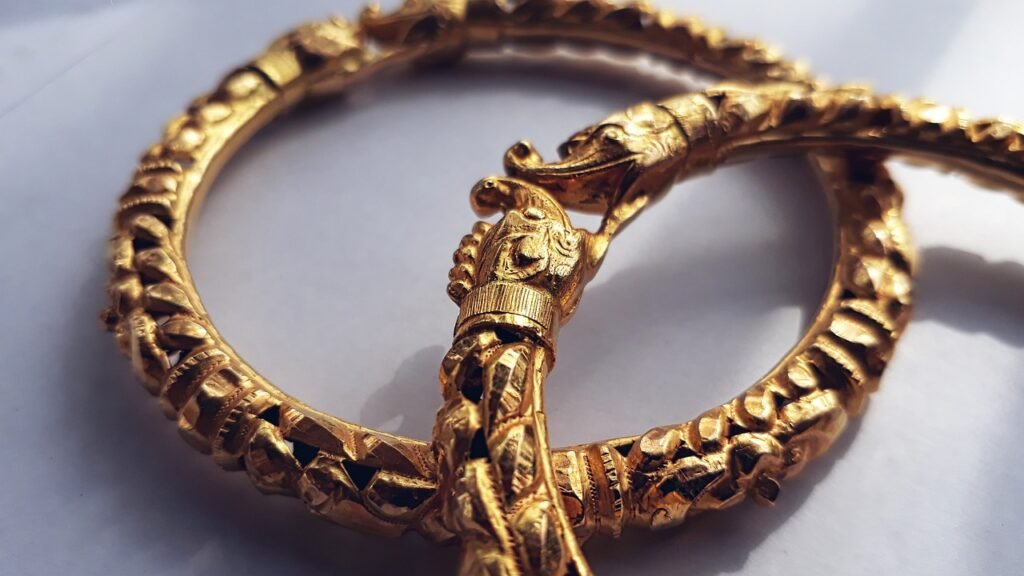Welcome to an informative article on exploring methods for assessing authenticity and quality in gold bracelets. In this piece, you will discover various techniques and tools that can help you determine the authenticity and quality of your gold jewelry. By learning about these methods, you will be equipped with the knowledge to make informed decisions when purchasing or valuing gold bracelets. Whether you are a budding collector or simply looking to authenticate a piece of jewelry, this article will provide you with valuable insights on how to ensure the authenticity and quality of your gold bracelets. Are you looking to invest in a gold bracelet but unsure about its authenticity and quality? In this article, we will explore various methods that you can use to assess the authenticity and quality of gold bracelets. From understanding gold purity to examining the craftsmanship, we will provide you with valuable insights to help you make an informed decision.

This image is property of pixabay.com.
Understanding Gold Purity
When it comes to assessing the authenticity and quality of a gold bracelet, the first aspect to consider is the gold purity. Gold purity is measured in karats, with 24 karats being the purest form of gold. However, pure gold is too soft for everyday wear, so it is often mixed with other metals to increase its durability and strength.
Gold Purity Markings
Gold jewelry is often stamped with markings that indicate its purity. Here are some common gold purity markings that you may come across:
- 24K: Pure gold
- 22K: High purity gold
- 18K: Standard for fine jewelry
- 14K: Most common for jewelry
- 10K: Minimum standard for gold in the United States
It is essential to look for these markings when purchasing a gold bracelet, as they provide valuable information about the gold content of the piece.
Assessing Craftsmanship
In addition to gold purity, the craftsmanship of a gold bracelet is crucial in determining its authenticity and quality. Paying attention to the details of the design and construction can give you insight into the skill and care that went into making the bracelet.
Examining the Clasp
One important aspect of a gold bracelet is the clasp, as it keeps the bracelet secure on your wrist. A high-quality gold bracelet will have a well-made and sturdy clasp that is easy to open and close. Check the clasp for any signs of wear or damage, as a weak or flimsy clasp may indicate poor craftsmanship.
Inspecting the Linkages
Another factor to consider when assessing the craftsmanship of a gold bracelet is the quality of the linkages. Each link should be smooth, symmetrical, and securely connected to the next link. Inspect the linkages closely for any gaps, rough edges, or inconsistencies, as these may be signs of poor craftsmanship.

This image is property of pixabay.com.
Conducting a Acid Test
If you want to verify the purity of a gold bracelet yourself, you can perform an acid test. An acid test involves using nitric acid to determine the gold content of a piece of jewelry. However, it is essential to note that acid testing can damage the piece, so it is best to perform this test as a last resort.
How to Perform an Acid Test
To perform an acid test on a gold bracelet, follow these steps:
- Select a discreet area of the bracelet, such as the clasp or an inconspicuous link.
- Scratch the surface of the gold in the chosen area.
- Apply a drop of nitric acid to the scratch mark.
- Observe the reaction of the acid with the gold. Genuine gold will not react or change color, while fake gold will turn greenish or brown.
It is important to exercise caution when performing an acid test and to ensure that you follow safety guidelines when handling nitric acid.
Seeking Professional Appraisal
If you are unsure about the authenticity and quality of a gold bracelet, it is always a good idea to seek a professional appraisal. A certified appraiser can assess the gold content, craftsmanship, and value of the bracelet, providing you with expert opinion and peace of mind.
What to Look for in a Professional Appraiser
When choosing a professional appraiser for your gold bracelet, consider the following factors:
- Credentials: Look for appraisers who have recognized certifications and qualifications in jewelry appraisal.
- Experience: Opt for appraisers who have extensive experience in evaluating gold jewelry.
- Reputation: Seek recommendations and read reviews to ensure that the appraiser is reputable and trustworthy.
A professional appraisal can give you valuable information about the authenticity and quality of your gold bracelet, helping you make an informed decision.

This image is property of pixabay.com.
Conclusion
Assessing the authenticity and quality of a gold bracelet is essential when making a significant investment in jewelry. By understanding gold purity, examining craftsmanship, conducting an acid test, and seeking professional appraisal, you can ensure that you are purchasing a high-quality and authentic gold bracelet. Remember to take your time when evaluating a gold bracelet and to prioritize quality and authenticity above all else. With the methods outlined in this article, you can make a confident and informed decision when purchasing a gold bracelet.
